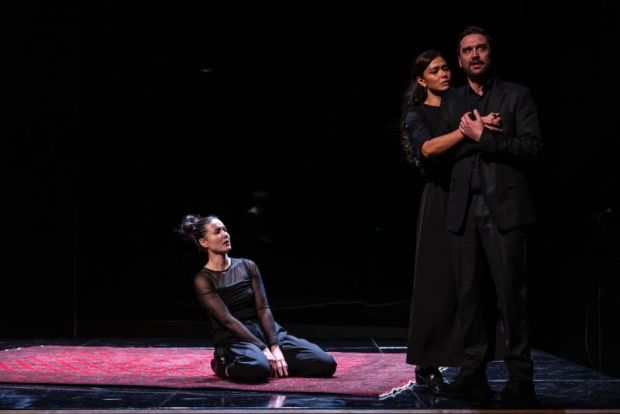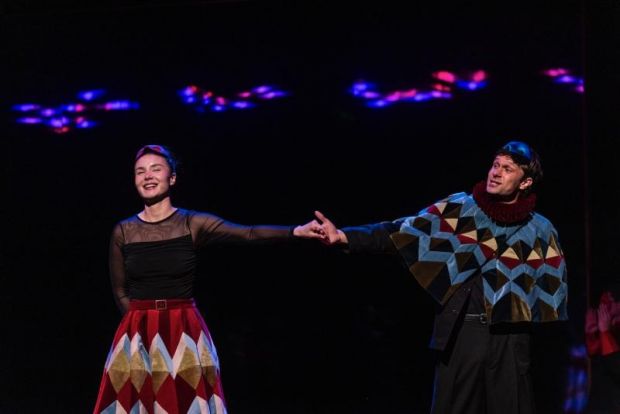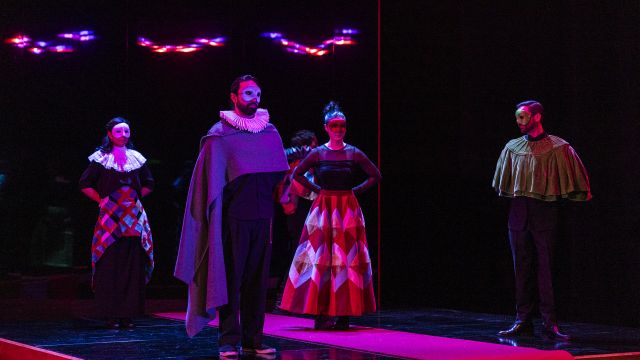Romeo & Juliet
The Bard’s famous romantic tragedy is exactly 400 years old today, give or take a year, and has been staged countless times in many languages — a ubiquity that may partly emerge from the play’s capture of the quintessence of many of our most powerful human feelings.
Romeo & Juliet is the epitome of romantic love in defiance of the frontlines of a long-running feud. In it, Romeo and Juliet meet on the dance floor, whereupon love instantly smites them both. Their love being proscribed by family loyalties, their only way to be together will be via a marriage conducted in strict secrecy.
Bell’s production — its third at least of this play in the company’s almost 35 years — has injected fresh contemporality into the production, not by altering lines or greatly distorting characters but simply by clearing out those rabbit-burrow lines that most readily block the audience’s absorption into the action.
And, as the tragedy unfolded, absorbed we were.
On the one hand, Romeo’s and Juliet’s wholehearted passion for each other, Romeo’s consequent familial love for his former enemies, the Prince’s relatively coolheaded decisions, and the Friar’s calmness, generosity, and cunning promised unending joy or at least hope and redemption. On the other, the rigid logic of vengeance; the implacable temper of Juliet’s cousin, Tybalt; the misguided authoritarianism of her father, Lord Capulet; Romeo’s tendency to allow despair to guide rash decisions; and the readiness of various characters to employ mortal means against themselves or others threatened heartbreaking possibilities of irrevocable loss. Beyond the power of the words themselves, the sublime acting drove all these things home. And the swordfights had a dynamism and reality that, belying their careful choreography, had us on the edges of our seats.

Underlying much of the play and supporting its emotional intensity was an unobtrusive soundtrack by Max Lyandvert that, though again certainly not 16th century, seemed entirely appropriate in its sound.
The set, a simple but appealing design by Anna Tregloan, who also designed the very smart costumes, adapts to convey the play’s various locales by smart use of carpets and lighting. And, though not all of the props and none of the costumes were exactly Elizabethan, none drew undue attention as anachronisms; we were able to focus entirely on the performance — which was spectacular. The costumes worn to the ball, though, were colourful marvels in themselves and, along with some special lighting, contributed to the ball’s joyousness.
Another aid to our absorption was the play’s headlong pace, a product of various characters’ unfortunate rigidities, uncharitableness, or impatient rashness.
By far the performance’s strongest aspect, though, was its uniformly consummate acting. Of course, you’d expect no less than that from any Bell Shakespeare production; but all actors become seasoned only through performance experience. In fact, one of its central characters — Juliet’s mother, Lady Capulet — is played superbly by a young woman whose first stage production this is: Adinia Wirasti. (It must be admitted, though, that Adinia is well-known in her home country of Indonesia for the many movies she has starred in.)
The on-stage chemistry between Ryan Hodson’s Romeo and Madeline Li’s Juliet, the barely controlled passions of all the characters, found convincing expression in the subtlest ways; it was certain that these two were made for each other and knew it, and their love was clearly lived in every moment.

Despite the need to project voices throughout a sizeable theatre, the performance of each actor was flawless, at times intimate, small gestures and changes in attitude showing us much of his or her internal world. It was this paradoxical feat in living a fictitious character that made the play so authentic that it could, at times, cause eruptions of laughter and, at others, bring tears to your eyes.
The play is scheduled to play on 26 stages around Australia in the next three months, and you would do yourself and your loved ones a favour to catch it at one of them. A tip: you may need to book early.
John P. Harvey
Images, from the top: [L–R] Adinia Wirasti, Khisraw Jones-Shukoor, Madeline Li, and Michael Wahr; [L–R] Madeline Li, Adinia Wirasti, and Michael Wahr; and [L–R] Madeline Li and Ryan Hodson, in Romeo & Juliet. Photographer: Brett Boardman.
Subscribe to our E-Newsletter, buy our latest print edition or find a Performing Arts book at Book Nook.

